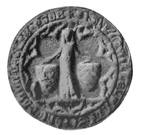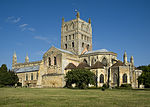Tewkesbury

Tewkesbury ( TEWKS-bər-ee) is a market town and civil parish in the north of Gloucestershire, England. The town grew following the construction of Tewkesbury Abbey in the twelfth century and played a significant role in the Wars of the Roses. It stands at the confluence of the River Severn and the River Avon, and thus became an important trading point, which continued as railways and, later, the M5 and M50 motorway connections were established. The town gives its name to the Borough of Tewkesbury, a local government district of Gloucestershire. The town lies on the border with Worcestershire, marked largely by the Carrant Brook (a tributary of the River Avon). The name Tewkesbury is thought to come from Theoc, the name of a Saxon who founded a hermitage there in the 7th century, and in the Old English language was called Theocsbury. An erroneous derivation from Theotokos (the Greek title of Mary, mother of God) enjoyed currency in the monastic period of the town's history. The Battle of Tewkesbury, which took place on 4 May 1471, was one of the decisive battles of the Wars of the Roses and is marked annually by a medieval festival in the town, including historical re-enactment.
Excerpt from the Wikipedia article Tewkesbury (License: CC BY-SA 3.0, Authors, Images).Tewkesbury
Church Street,
Geographical coordinates (GPS) Address Nearby Places Show on map
Geographical coordinates (GPS)
| Latitude | Longitude |
|---|---|
| N 51.99 ° | E -2.16 ° |
Address
Tewkesbury Abbey
Church Street
GL20 5SA , Priors Park
England, United Kingdom
Open on Google Maps










